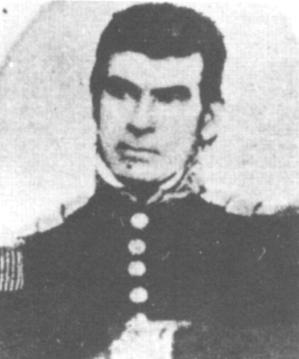|
|
||||
 |
||||
URREA, JOSÉ DE (1797-1849).
 José
de Urrea, military officer, was born in 1797 in the presidio of Tucson, Sonora
(now Arizona). He was a military cadet in the presidial company of San Rafael
Buenavista in 1809 and a lieutenant in 1816, participating in battles in Jalisco
and Michoacán. In 1821 he supported the Plan of Iguala of Agustín de Iturbide.qv
He participated in the anti-Iturbide Plan of Casa Mata and the siege of San Juan
de Uluá. Affiliated with the Plan of Montaño, Urrea was separated from army
service, but in 1829 he reentered and fought in Tampico with Antonio López de
Santa Annaqv against Isidro Barradas. He intervened in the Plan of
Jalapa against the government of Vicente Ramón Guerreroqv and when
Anastasio Bustamanteqv came to power (1829-30), Urrea was named to
the secretariat of the command in Durango. He was made a lieutenant colonel in
1831. In July 1832, along with Santa Anna, he declared for Gómez Pedraza, and
in 1834 he assumed the command of the permanent regiment of Cuautla, near
Cuernavaca, after having received the rank of colonel from Francisco Ellorriaga,
whom he had supported. As acting general in July 1835, he was sent to fight the
Comanches in Durango, where he was commandant general and then governor in
September and October. He participated in the expedition to Texas in 1836 and
was engaged in the battles at San Patricio, Agua Dulce Creek, and Coleto.qv
Urrea was opposed to the withdrawal of Mexican troops ordered by the captive
Santa Anna after the battle of San Jacinto. In 1837 he was named commandant
general of the departments of Sinaloa and Sonora. In December, upon being passed
over for the appointment of governor, he proclaimed the two departments under
the federal system, whereupon he was designated constitutional governor and
protector. He then turned over his executive office to the vice governor and
marched on opposing forces at Mazatlán, where he was defeated. He fled to
Guaymas and finally to Durango, where he became involved in yet another
uprising. In 1839 he was captured and sent to Perote Prison.qv Later
during an imprisonment in Durango he was rescued by his partisans to take part
in a revolt. In 1842 he assumed the executive power of Sonora, which he held
until May 1844. In 1846 he fought against the United States in the Mexican War.qv
He died in 1849.
José
de Urrea, military officer, was born in 1797 in the presidio of Tucson, Sonora
(now Arizona). He was a military cadet in the presidial company of San Rafael
Buenavista in 1809 and a lieutenant in 1816, participating in battles in Jalisco
and Michoacán. In 1821 he supported the Plan of Iguala of Agustín de Iturbide.qv
He participated in the anti-Iturbide Plan of Casa Mata and the siege of San Juan
de Uluá. Affiliated with the Plan of Montaño, Urrea was separated from army
service, but in 1829 he reentered and fought in Tampico with Antonio López de
Santa Annaqv against Isidro Barradas. He intervened in the Plan of
Jalapa against the government of Vicente Ramón Guerreroqv and when
Anastasio Bustamanteqv came to power (1829-30), Urrea was named to
the secretariat of the command in Durango. He was made a lieutenant colonel in
1831. In July 1832, along with Santa Anna, he declared for Gómez Pedraza, and
in 1834 he assumed the command of the permanent regiment of Cuautla, near
Cuernavaca, after having received the rank of colonel from Francisco Ellorriaga,
whom he had supported. As acting general in July 1835, he was sent to fight the
Comanches in Durango, where he was commandant general and then governor in
September and October. He participated in the expedition to Texas in 1836 and
was engaged in the battles at San Patricio, Agua Dulce Creek, and Coleto.qv
Urrea was opposed to the withdrawal of Mexican troops ordered by the captive
Santa Anna after the battle of San Jacinto. In 1837 he was named commandant
general of the departments of Sinaloa and Sonora. In December, upon being passed
over for the appointment of governor, he proclaimed the two departments under
the federal system, whereupon he was designated constitutional governor and
protector. He then turned over his executive office to the vice governor and
marched on opposing forces at Mazatlán, where he was defeated. He fled to
Guaymas and finally to Durango, where he became involved in yet another
uprising. In 1839 he was captured and sent to Perote Prison.qv Later
during an imprisonment in Durango he was rescued by his partisans to take part
in a revolt. In 1842 he assumed the executive power of Sonora, which he held
until May 1844. In 1846 he fought against the United States in the Mexican War.qv
He died in 1849.
BIBLIOGRAPHY: Diccionario Porrúa de historia, biografía y geografía de México (3d ed., 2 vols., Mexico City: Editorial Porrúa, 1970, 1971).
Shelia M. Ohlendorf